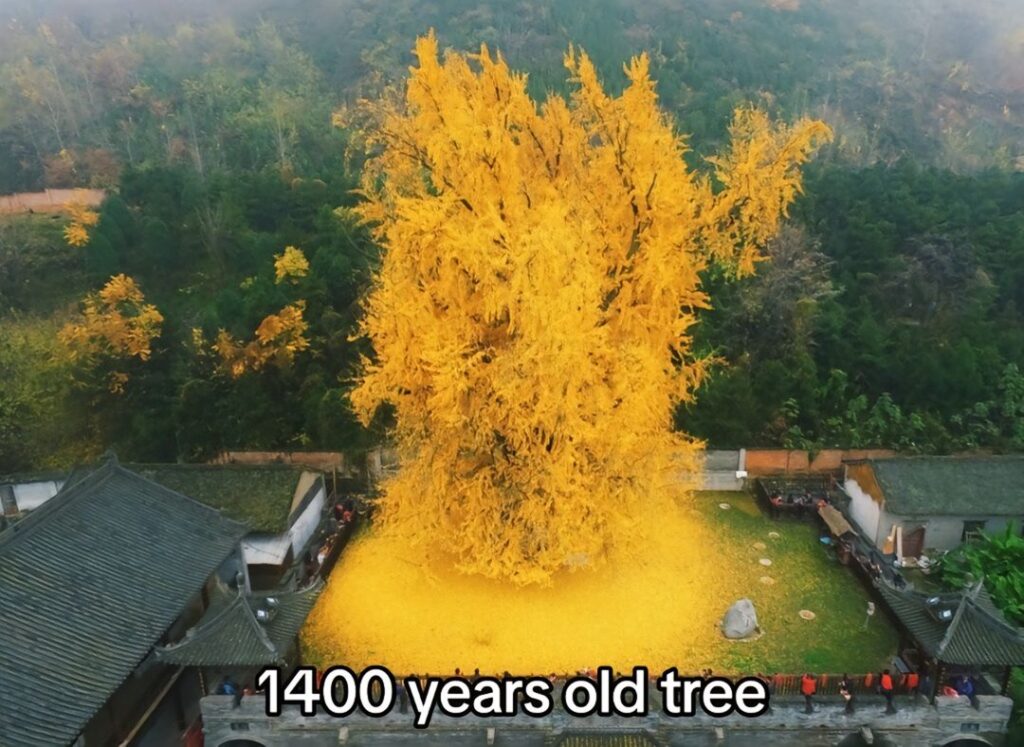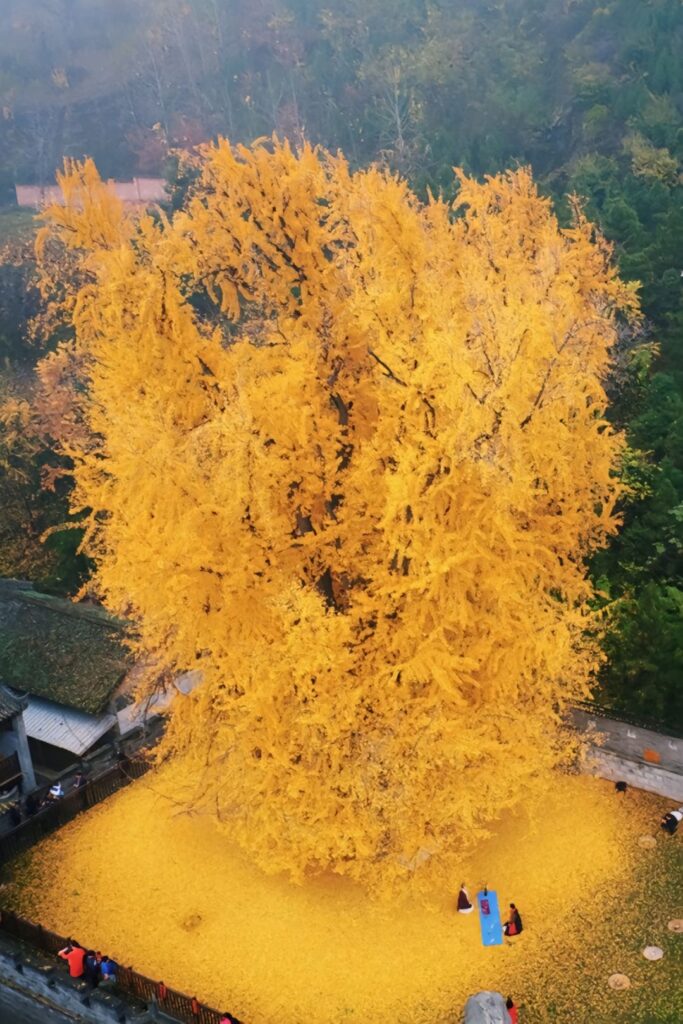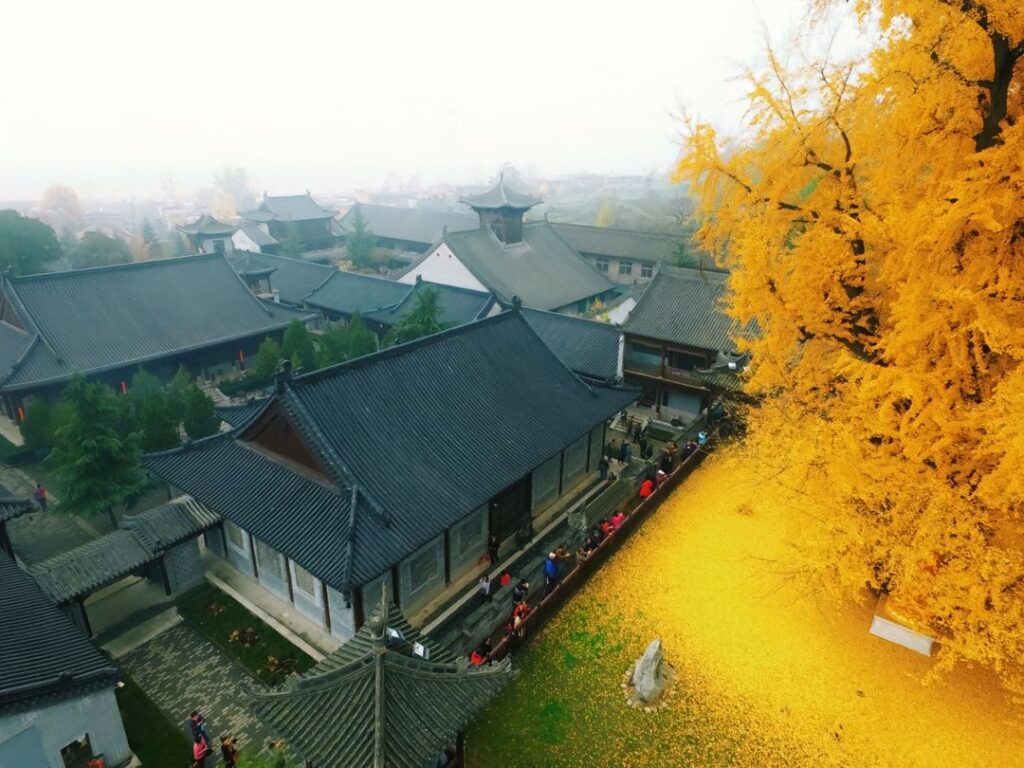Location and Historical Context
- Temple Connection: The tree stands within the grounds of the Gu Guanyin Temple, located in the Zhongnan Mountains, near Xi’an in Shaanxi Province, China.
- Tang Dynasty Legacy: It is believed to have been planted during the Tang Dynasty (618–907 CE), a period known for cultural and spiritual flourishing in China. The tree likely served as a living testament to harmony between nature and spirituality. Phenomenal Autumn Display
- Golden Transformation: Every autumn (usually from mid-October to mid-November), the tree’s fan-shaped leaves turn a brilliant shade of gold.
- Golden Carpet Effect: The leaves fall symmetrically, creating a golden carpet around the base of the tree. This mesmerizing sight draws thousands of visitors and photographers from around the world.
- Symbol of Change: In Chinese culture, the falling leaves are often seen as a symbol of letting go and the cycle of life, aligning with Buddhist teachings. Physical Characteristics
- Height and Canopy: The tree is massive, towering over 50 feet tall, with an impressive canopy spread.
- Health and Vitality: Despite its age, the tree remains remarkably healthy, which is a testament to the durability of ginkgo trees. General Facts About Ginkgo Trees1. Ancient Origins: Ginkgos are the sole survivors of the Ginkgoaceae family, which dates back to the Jurassic period.

- Hardy and Resilient: Ginkgo trees are highly resistant to pollution, pests, and diseases, making them popular in urban environments. They were among the first plants to regrow in Hiroshima after the atomic bomb in 1945.
- Distinctive Leaves: The fan-shaped, bilobed leaves are unique and often turn a stunning golden-yellow color in autumn.
- Longevity: These trees are known to live for centuries. Some specimens are thought to be over 3,000 years old.
- Medicinal Uses: Ginkgo extracts are used in traditional medicine, believed to improve memory and circulation.
- Reproductive Peculiarities: Ginkgos are dioecious, meaning there are male and female trees.
Female trees produce seeds encased in a fleshy, foul-smelling coating, while male trees are preferred for urban planting.

The 1,400-year-old ginkgo tree at the Gu Guanyin Temple in China is an extraordinary natural marvel and a symbol of history, spirituality, and resilience. Nestled in the Zhongnan Mountains of the Shaanxi Province, this ancient tree attracts thousands of visitors each year, particularly during the fall when its golden leaves transform the temple grounds into a mesmerizing sea of gold.
This magnificent ginkgo tree, known as the “living fossil” because its species has existed for over 200 million years, is one of the most iconic landmarks in the area. The tree is deeply intertwined with the history of the Gu Guanyin Temple, a Buddhist site dating back over a thousand years. According to legend, the tree was planted during the Tang Dynasty by Emperor Taizong (598–649 CE) or by a monk who served at the temple, further enhancing its mystique.
One of the most stunning aspects of this tree is its spectacular autumn display. Every year, between late October and early December, the tree’s fan-shaped leaves turn a radiant golden-yellow, blanketing the ground in a breathtaking carpet of gold. This natural phenomenon draws not only tourists and photographers but also spiritual seekers and nature enthusiasts who marvel at the serene beauty of the tree in harmony with the ancient temple architecture.
The ginkgo tree is revered in Chinese culture, symbolizing resilience, longevity, and peace. Its ability to survive through millennia, including periods of war, natural disasters, and human activity, reflects its extraordinary durability. Ginkgo trees are known for their resistance to pests, diseases, and environmental stress, which may explain why this particular tree has thrived for over 1,400 years.
The Gu Guanyin Temple itself is a place of tranquility and spiritual reflection, and the tree amplifies this atmosphere. It serves as a reminder of the passage of time and the enduring nature of life. Visitors often feel a sense of awe standing beneath the massive canopy, imagining the countless generations who have stood in the same spot, gazing at the same tree. The temple’s monks and caretakers ensure the tree remains healthy, preserving it for future generations to enjoy and honor.
The ginkgo tree at the Gu Guanyin Temple also holds ecological significance. Ginkgo biloba, the species to which this tree belongs, is unique as the only surviving member of its plant family, dating back to prehistoric times. Its existence serves as a bridge between ancient ecosystems and the modern world, a living testament to the resilience of nature.

For the local community and visitors alike, the ginkgo tree is more than a natural wonder; it’s a cultural and spiritual treasure. Its seasonal beauty is a symbol of renewal and the cyclical nature of life, inspiring visitors to reflect on their connection to the world and their place within it. As a natural monument, it reminds us of the importance of preserving such ancient and irreplaceable wonders, which connect humanity to the deep history of our planet.
The 1,400-year-old ginkgo tree at Gu Guanyin Temple is not merely a tree—it’s a piece of living history, a spiritual icon, and a profound example of the harmony between nature and humanity. Its enduring presence is a source of wonder, inspiration, and a reminder of the enduring power of life through time.


